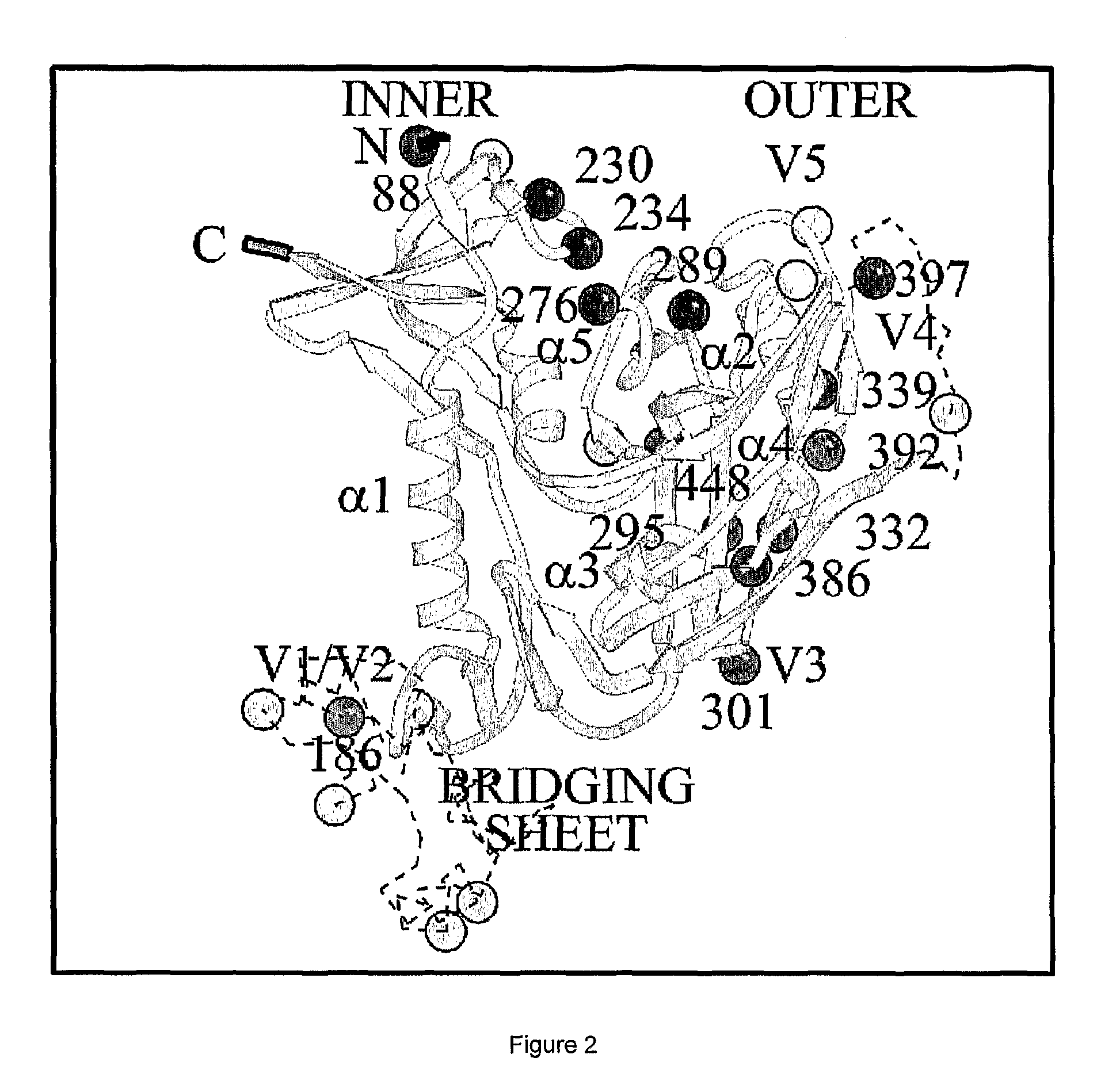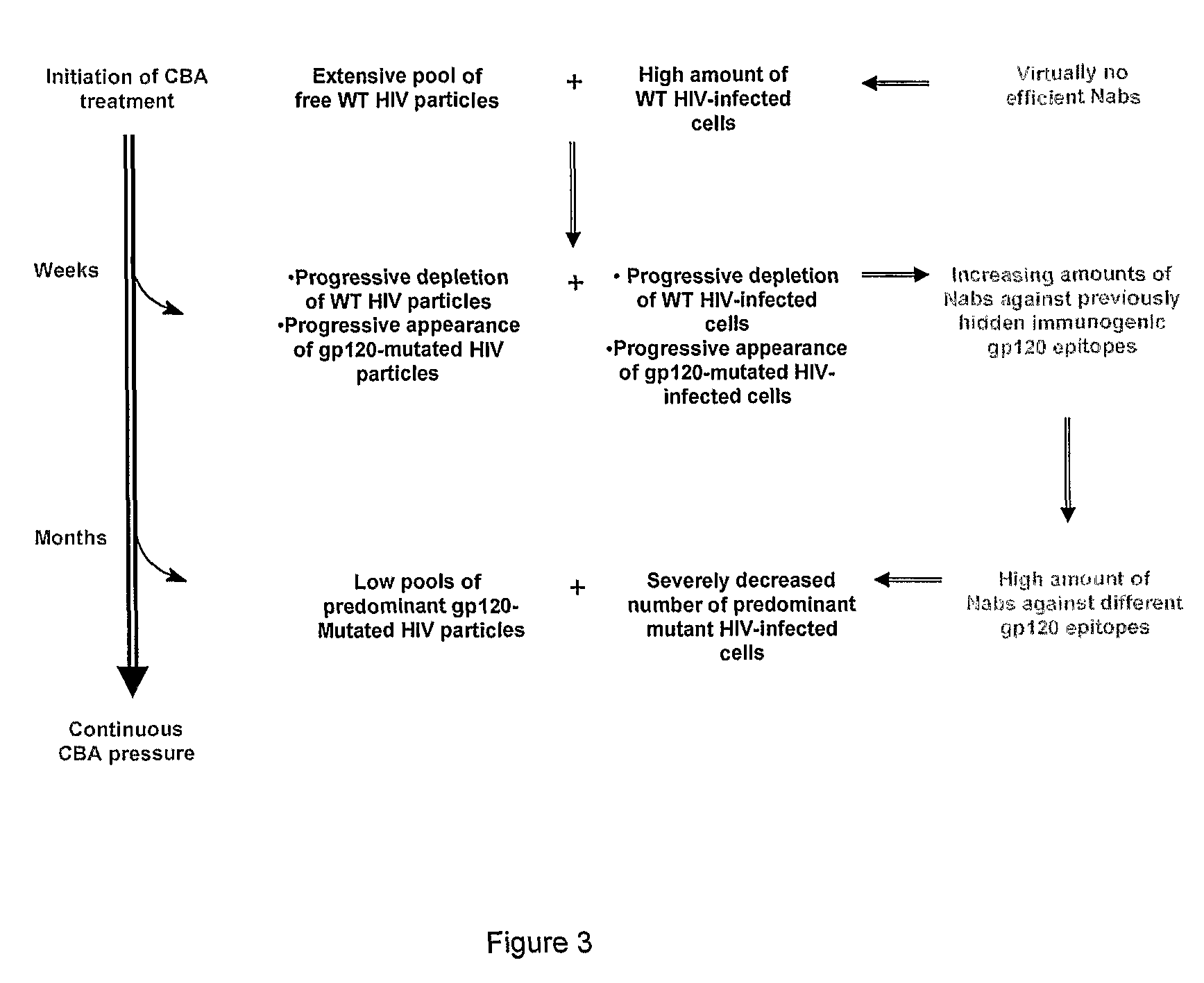Antiviral therapies
a technology of antiviral therapy and carbohydrate binding, applied in the field of carbohydrate binding compounds, can solve the problems of chronic carriers at risk of developing cirrhosis and/or liver cancer, major health problems worldwide for mammals including humans, and major medical problems such as viral infections
- Summary
- Abstract
- Description
- Claims
- Application Information
AI Technical Summary
Benefits of technology
Problems solved by technology
Method used
Image
Examples
example 1
General methods for Antiviral Screening
[0210]Anti-H / V assay: The inhibitory activity of compounds of the invention were be tested for their potential to inhibit the replication of HIV and SIV in a cell culture model for acute infection. Compounds were tested against HIV-1 strains (HE, NL43, MN, IIIB), HIV-2 strains (ROD, EHO, RF), and SIV (MAC251) for inhibition of virus-induced cytopathicity in MT-4 cells (or CEM or C8166 or Molt4 / C8 cells), using the colorimetric test described by Pauwels et al. in J. Virol. Methods (1988) 20:309-321 or a microscopic investigation of the cytopathogenic effect, evaluation being made 4 to 5 days post-infection. For example microtiter 96-well plates containing ˜3×105 CEM cells / ml, infected with 100 CClD50 of HIV per ml and containing appropriate dilutions of the test compounds were used.
[0211]A rapid and automated assay procedure was used for the in vitro evaluation of anti-HIV agents. An HTLV-1 transformed T4-cell line MT-4, which was previously sho...
example 2
Materials and General Preparation Methods of Carbohydrate Binding Small Molecules or Agents
[0228]The compounds of the present invention can easily be prepared by a person skilled in the art while using a series of chemical reactions known to those skilled in the art and as described in the prior art such as for[0229](a) porphyrins and derivatives or analogues thereof as described in Mizutani et al. (J. Am. Chem. Soc. 1997, 119: 8991-9001);[0230](b) phenylboronic acid comprising compounds or polymers, such as described in Uchimura et al. (Biotechnol. Bioengineer. 2001, 72: 307-314);[0231](c) Diethylenetriaminecopper(II) complexes, such as in Striegler (Tetrahedron 2001, 57: 2349-2354);[0232](d) Acyclic pyridine / pyrimidine-based carbohydrate receptors, such as in Mazik et al., (J. Am. Chem. Soc. 2005, 127: 9045-9052); and for[0233](e) Multivalent polyphenolic derivatives, such as in Hamashin et al. (Bioorg. Med. Chem. 2003, 11: 4991-4997);
which are all incorporated herein by reference...
example 3
Inhibition of HIV and HCV Infection by CBA
[0235]The inhibitory activities of carbohydrate binding small molecules and agents against infectious HIV-1 (strain IIIB), HIV-2 (strain ROD) and HCVcc (subtype 2a) were evaluated in human T lymphocyte cells (CEM) and human hepatocellular carcinoma cells (Huh-7), respectively (Table 1). The mannose-specific plant lectins GNA, HHA and CA inhibited infection by both types of viruses at EC50s that varied over an order of magnitude, between 0.003 and 0.030 μM. The GlcNAc-specific plant lectin UDA and the mannose-specific non-peptidic antibiotic pradimicin A (PRM-A) also markedly inhibited HIV and HCVcc infection, although UDA was ten-fold more potent than PRM-A. There was a strong correlation between the inhibitory activity of the different CBA against both viruses (r=0.934, FIG. 4, panel A) and the potency of each CBA against HIV and HCV was within the same order of magnitude (Table 1, FIG. 4). In other words, the more inhibitory a CBA was agai...
PUM
| Property | Measurement | Unit |
|---|---|---|
| dissociation constant | aaaaa | aaaaa |
| dissociation constant | aaaaa | aaaaa |
| time | aaaaa | aaaaa |
Abstract
Description
Claims
Application Information
 Login to View More
Login to View More - R&D
- Intellectual Property
- Life Sciences
- Materials
- Tech Scout
- Unparalleled Data Quality
- Higher Quality Content
- 60% Fewer Hallucinations
Browse by: Latest US Patents, China's latest patents, Technical Efficacy Thesaurus, Application Domain, Technology Topic, Popular Technical Reports.
© 2025 PatSnap. All rights reserved.Legal|Privacy policy|Modern Slavery Act Transparency Statement|Sitemap|About US| Contact US: help@patsnap.com



